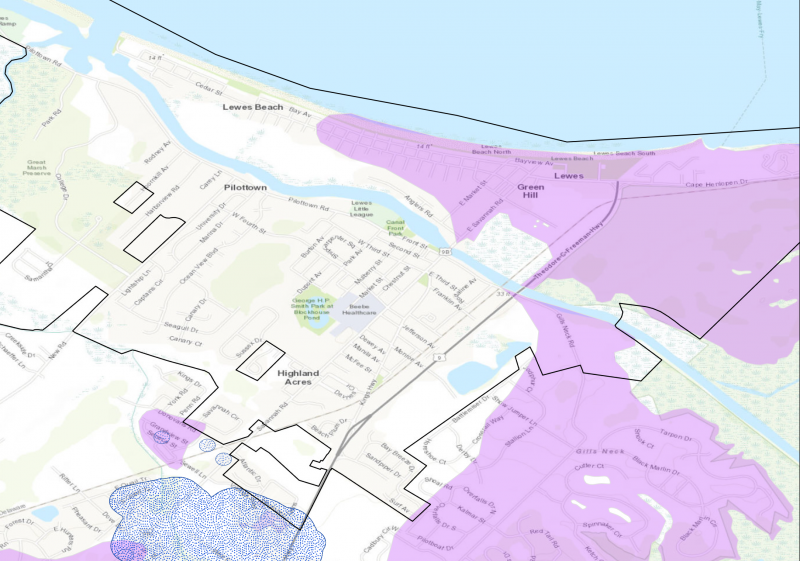A petition signed by 143 people urges Lewes officials to take a step back on proposed source water protection and sea-level rise ordinances.
Lewes Beach residents Kevin and Kath McGuiness authored the document, which calls on city officials to compile a comprehensive record that’s shared with all stakeholders before any action is taken.
“We believe a comprehensive record is one that allows questions to be asked and answered; and addresses, among other things, the factual and scientific justifications for the ordinances, whether less restrictive and more effective means were considered, and the legal and economic risks of adoption to the city and its residents,” the petition reads.
Mayor and city council is set to have public hearings on both the sea-level rise ordinance and the source water protection ordinance at 6 p.m., Monday, May 3. It’s possible council could adopt both ordinances as early as its regular meeting Monday, May 17.
In March, the planning commission offered a positive recommendation on a proposed sea-level rise ordinance, which creates a formula to determine the required height for the first occupied floor of buildings based on sea-level rise projections 50 years in the future. The ordinance allows up to 50 percent lot coverage, but can be increased to 60 percent with implementation of three runoff reduction practices.
The ordinance would apply to all redevelopment of residential property and new construction of critical facilities within the 100- and 500-year flood plains. New residential development is expected to be addressed at a later time.
On April 1, the city’s planning commission voted 7-2 to recommend approval of a draft ordinance that limits maximum impervious cover to 50 percent on all lots, no matter their zoning, located within the defined excellent recharge area. If adopted, the new regulation would also require all driveways, sidewalks, patios and decks to be made of permeable materials.
The excellent recharge area covers much of Lewes Beach, including all of Cape Henlopen Drive and many of the properties northwest of Savannah Road up to about Kentucky Avenue.
Following the April 1 vote on the recharge ordinance, some planning commission members expressed a desire to similarly align the sea-level rise ordinance, meaning they would like to see the 60 percent lot coverage option eliminated.
City officials and staff have been working to update the source water protection ordinance after it was discovered the city had not been enforcing its requirements for more than a decade.
At their Feb. 8 meeting, city officials, without a vote, decided to strictly enforce the existing ordinance, which allows a maximum of 20 percent lot coverage on properties within the excellent recharge area. Applicants can increase lot coverage to 50 percent with an environmental impact assessment report that shows post-development water recharge will be no less than pre-development recharge. Some residents have described the assessment as too costly.
Plans for many Lewes Beach property owners are on hold while the city works on new standards. The petition asks the city to handle new and existing applications as it did prior to council’s Feb. 8 meeting.
Kevin McGuiness says he believes his neighbors signed the petition for a variety of reasons, but one reason is to better address the issue of flooding.
“Flooding is not a hypothetical issue if you live on the beach,” he said. “It’s a real problem, and it needs a real solution. Raising [concerns] doesn’t mean you don’t think flooding is an issue. It doesn’t mean you don’t believe in climate change. It means you want to get to an effective solution.”
He believes more time will enable the city to consider all aspects and consequences of the proposed ordinances and to work with those who will be most affected.
McGuiness said it’s difficult to understand what the city wants to do, because the work various committees and commissions are doing is often contradictory.
“We have the planning commission laser focused on accumulating as much square footage of pervious land as possible, but at the same time, the city is doing different things and considering different proposals that would seem to be eliminating pervious cover,” he said. “It all seems a little counterintuitive.”
One key area the city has overlooked, McGuiness said, is how the ordinances will impact property values, the status of mortgages and insurance coverage, and ultimately the impact on the city’s coffers.
“If our house burns down tomorrow, can we rebuild it? Or does it have to be built in accordance with the [proposed] ordinances if they become law?” he said. "That’s not just an issue for us, that’s a huge issue for mortgage companies because they are presuming if you default on a mortgage, they can rebuild or recoup their money. If you can’t rebuild, that’s a big issue for insurance companies.”
There are about 1,200 homes impacted by the two proposed ordinances. Taking the average price of a Lewes home and multiplying it by 1,200 yields a value well over half a billion dollars, he said.
“If you’re taking a third of the city and diminishing the value of the property ... there’s an economic consequence for the city in terms of revenue/taxes,” he said. “They’ll have a revenue shortfall.”
Nick Roth is the news editor. He has been with the Cape Gazette since 2012, previously covering town beats in Milton and Lewes. In addition to serving on the editorial board and handling page layout, Nick is responsible for the weekly Delaware History in Photographs feature and enjoys writing stories about the Cape Region’s history. Prior to the Cape Gazette, Nick worked for the Delmarva Media Group, including the Delaware Wave, Delaware Coast Press and Salisbury Daily Times. He also contributed to The News Journal. Originally from Boyertown, Pa., Nick attended Shippensburg University in central Pennsylvania, graduating in 2007 with a bachelor’s degree in journalism. He’s won several MDDC awards during his career for both writing and photography. In his free time, he enjoys golfing, going to the beach with his family and cheering for Philadelphia sports teams.























































